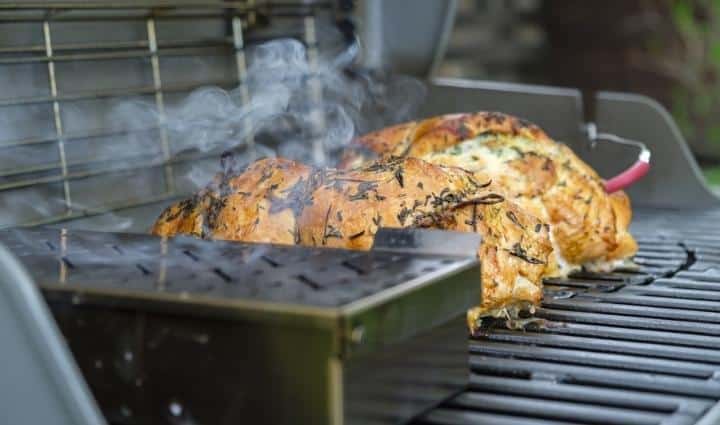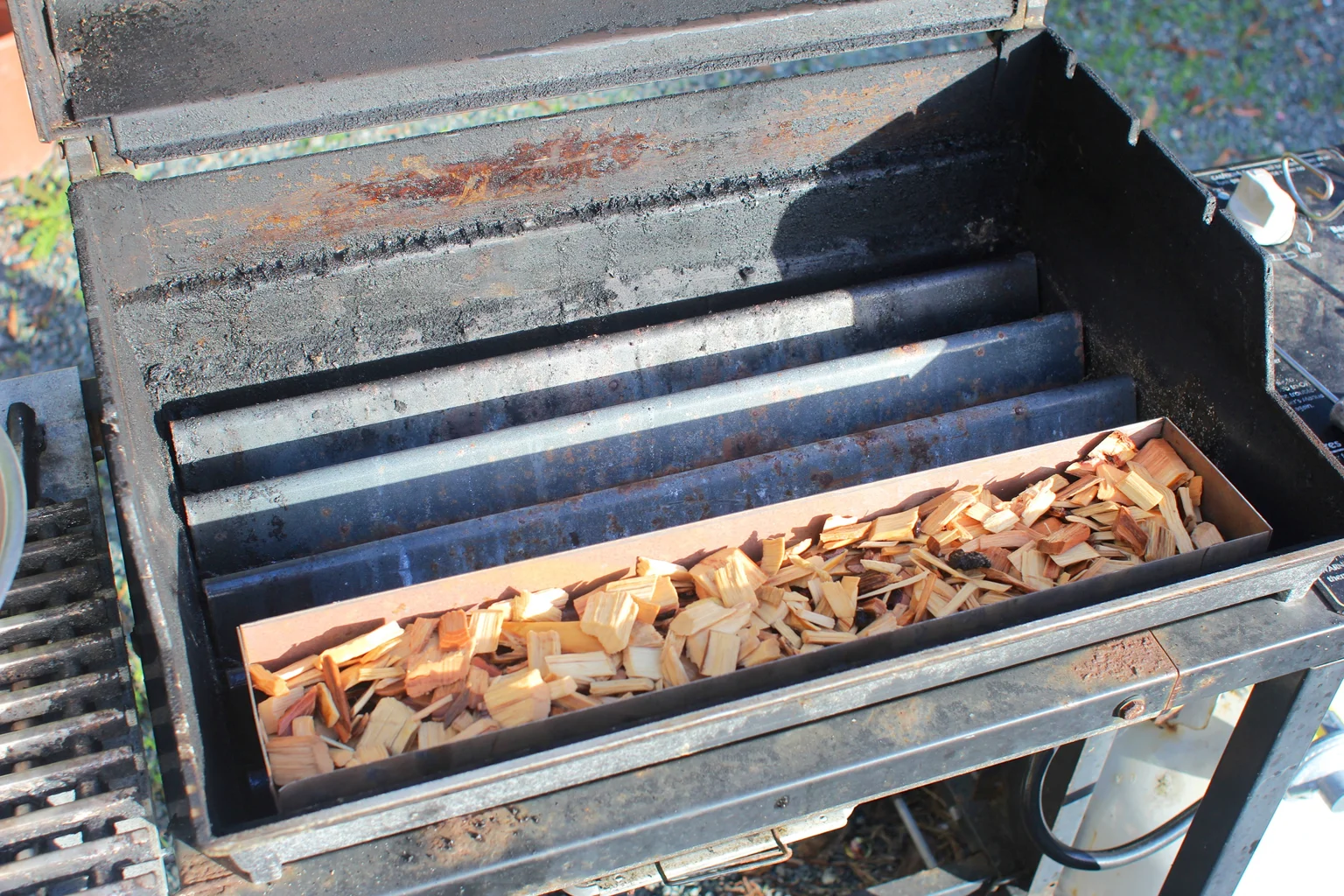How to turn a gas grill into a smoker? To turn a gas grill into a smoker, place soaked wood chips in a foil packet or smoker box over one burner, set the other burner(s) to low heat, and adjust the temperature to achieve the desired smoking environment for your food.
Unlock the Secret to Perfectly Smoked Meat on Your Gas Grill
Smoking meat is a time-honored tradition that has been practiced for centuries. It is a cooking method that infuses meat with a rich, smoky flavor and tenderizes it to perfection. While traditional smokers are often used for this purpose, many people are now turning to their gas grills as a convenient and efficient way to smoke meat. In this article, we will explore the benefits of smoking meat on a gas grill and provide you with tips and techniques to achieve delicious and flavorful results.
One of the main advantages of using a gas grill for smoking meat is the convenience it offers. Gas grills are readily available and can be easily found in most households. They provide a consistent source of heat, allowing for precise temperature control, which is crucial when smoking meat. Additionally, gas grills are quick to heat up and require minimal maintenance compared to traditional smokers. This makes them an ideal choice for those who want to enjoy the flavors of smoked meat without the hassle of tending to a fire for hours on end.
Benefits of Smoking Meat on a Gas Grill
There are several benefits to smoking meat on a gas grill that make it an attractive option for both beginners and experienced grillers alike.
Firstly, smoking meat on a gas grill enhances its flavor and tenderness. The combination of low, slow cooking and the infusion of smoky flavors from wood chips creates a depth of flavor that cannot be achieved through other cooking methods. The smoke penetrates the meat, adding complexity and richness to every bite. Additionally, the slow cooking process breaks down tough connective tissues in the meat, resulting in tender and juicy results.
Secondly, smoking meat on a gas grill is a healthier cooking method compared to other techniques such as frying or grilling over high heat. The low temperature used in smoking helps to retain the natural juices and nutrients in the meat, while allowing excess fat to drip away. This results in a leaner and healthier final product.
Lastly, smoking meat on a gas grill offers versatility in smoking different types of meat. Whether you’re smoking beef, pork, chicken, or fish, a gas grill can handle it all. With the right techniques and temperature control, you can achieve delicious results with any cut of meat.
Setting up Your Gas Grill for Smoking Meat
Before you start smoking meat on your gas grill, it’s important to properly prepare the grill and gather the necessary equipment and tools. This will ensure that you have a smooth and successful smoking experience.
To prepare your gas grill for smoking, start by cleaning the grates and removing any debris or leftover food. This will prevent any unwanted flavors from transferring to your meat. Next, remove the heat shields or flavorizer bars to create indirect heat. Indirect heat is essential for smoking as it allows for slow and even cooking without direct exposure to the flames.
In terms of equipment and tools, you will need a smoker box or aluminum foil pouch to hold your wood chips. This will allow the wood chips to smolder and release their smoky flavors throughout the cooking process. You will also need a reliable meat thermometer to monitor the internal temperature of your meat and ensure it reaches the desired level of doneness.
When setting up your gas grill for smoking, it’s important to follow safety precautions. Make sure your grill is placed in a well-ventilated area away from any flammable materials. Always keep a fire extinguisher nearby in case of emergencies. Additionally, be cautious when handling hot surfaces and use heat-resistant gloves or tongs to avoid burns.
Choosing the Right Wood Chips for Smoking Meat on a Gas Grill
Choosing the right wood chips is crucial when smoking meat on a gas grill as it directly impacts the flavor profile of your final product. Different types of wood chips impart different flavors, so it’s important to choose the right wood chips that complement the type of meat you’re smoking.
Some popular types of wood chips for smoking include hickory, mesquite, apple, cherry, and oak. Hickory is known for its strong and smoky flavor, making it a great choice for beef and pork. Mesquite, on the other hand, has a bold and intense flavor that pairs well with red meats. Apple and cherry wood chips offer a sweeter and milder flavor that works well with poultry and fish. Oak is a versatile option that provides a balanced and mild smoky flavor that complements a variety of meats.
When choosing wood chips, it’s important to consider the intensity of the flavor you want to achieve. For a lighter smoky flavor, use fewer wood chips or choose a milder wood variety. If you prefer a stronger smoky flavor, use more wood chips or opt for a stronger wood variety.
Soaking wood chips before using them in your gas grill is a common practice that can enhance the smoking process. Soaking wood chips in water for at least 30 minutes before use helps to slow down the burning process and prolongs the release of smoke. This allows for a more controlled and consistent smoking experience. However, it’s important to note that soaking wood chips is not necessary and some grillers prefer to use dry wood chips for a more intense smoky flavor.
Preparing Your Meat for Smoking on a Gas Grill
To achieve the best results when smoking meat on a gas grill, it’s important to properly prepare your meat before cooking.
Start by choosing the right cut of meat for smoking. While almost any cut of meat can be smoked, certain cuts are better suited for this cooking method. For example, cuts with higher fat content such as brisket or pork shoulder are ideal for smoking as the slow cooking process helps to render the fat and create a tender and flavorful result. Leaner cuts such as chicken breasts or fish fillets can also be smoked, but may require additional steps to prevent them from drying out.
Once you’ve chosen your cut of meat, consider brining it before smoking. Brining involves soaking the meat in a solution of salt, sugar, and water to enhance its flavor and tenderness. The salt in the brine helps to break down the muscle fibers in the meat, resulting in a more tender and juicy final product. Additionally, the sugar in the brine adds a touch of sweetness to balance out the smoky flavors.
After brining, season your meat with a dry rub or marinade to add additional flavor. Dry rubs are a mixture of herbs, spices, and seasonings that are applied directly to the surface of the meat. They create a flavorful crust that enhances the taste of the meat. Marinades, on the other hand, are liquid-based mixtures that are used to infuse flavor into the meat. They typically contain a combination of acidic ingredients such as vinegar or citrus juice, along with herbs, spices, and other flavorings.
Once your meat is brined and seasoned, it’s ready for smoking on your gas grill.
Temperature Control for Smoking Meat on a Gas Grill
Temperature control is crucial when smoking meat on a gas grill as it determines the cooking time and ensures that your meat reaches the desired level of doneness.
To set up your gas grill for temperature control, start by preheating it to the desired smoking temperature. This will vary depending on the type of meat you’re smoking. As a general guideline, aim for a temperature range of 225°F to 250°F for most cuts of meat. This low and slow cooking method allows for optimal tenderness and flavor development.
To achieve indirect heat on your gas grill, turn off one or more burners and place your meat on the unlit side of the grill. This will create a zone of indirect heat where the meat can cook slowly and evenly without direct exposure to the flames. It’s important to keep the lid closed as much as possible during the smoking process to maintain a consistent temperature.
Monitoring and adjusting the temperature throughout the smoking process is essential. Use a reliable meat thermometer to check the internal temperature of your meat regularly. This will help you determine when it’s done and prevent overcooking or undercooking. Additionally, if the temperature of your grill starts to drop, you may need to adjust the burner settings or add more wood chips to maintain a steady heat.
Smoking Techniques for Different Types of Meat
Different types of meat require different smoking times and temperatures to achieve optimal results. Here are some techniques for smoking beef, pork, chicken, and fish on a gas grill:
– Beef: For cuts such as brisket or ribs, aim for a smoking temperature of 225°F to 250°F and a cooking time of 1 to 1.5 hours per pound. Start by searing the meat over direct heat for a few minutes on each side to develop a crust, then move it to the indirect heat side of the grill to finish cooking. For steaks or burgers, use higher heat (around 350°F) and shorter cooking times (about 30 minutes) for a medium-rare or medium doneness.
– Pork: Pork shoulder or pork ribs are ideal for smoking on a gas grill. Aim for a smoking temperature of 225°F to 250°F and a cooking time of 1.5 to 2 hours per pound for pork shoulder, and 4 to 6 hours for pork ribs. Start by searing the meat over direct heat for a few minutes on each side, then move it to the indirect heat side of the grill to finish cooking.
– Chicken: For whole chickens or chicken pieces, aim for a smoking temperature of 275°F to 300°F and a cooking time of 2 to 3 hours for a whole chicken, and 1 to 1.5 hours for chicken pieces. Start by searing the chicken over direct heat for a few minutes on each side, then move it to the indirect heat side of the grill to finish cooking.
– Fish: Fish fillets or whole fish can be smoked on a gas grill. Aim for a smoking temperature of 225°F to 250°F and a cooking time of 30 minutes to 1 hour, depending on the thickness of the fish. Use a fish basket or aluminum foil to prevent the fish from sticking to the grates.
To add additional flavor to your smoked meat, consider using marinades or rubs. Marinades can be applied before smoking to infuse flavor into the meat, while rubs can be applied before or during the smoking process to create a flavorful crust.
Tips for Achieving Perfectly Smoked Meat on a Gas Grill
Achieving perfectly smoked meat on a gas grill requires patience and attention to detail. Here are some tips to help you achieve delicious results:
– Be patient: Smoking meat is a slow and gradual process that requires patience. Resist the temptation to constantly check on your meat or open the lid of your grill. This will only cause fluctuations in temperature and prolong the cooking time.
– Use a meat thermometer: A reliable meat thermometer is essential when smoking meat on a gas grill. It allows you to monitor the internal temperature of your meat and ensure it reaches the desired level of doneness. Insert the thermometer into the thickest part of the meat, away from any bones or fat.
– Rest your meat after smoking: After your meat is done smoking, it’s important to let it rest before slicing or serving. This allows the juices to redistribute throughout the meat, resulting in a more tender and flavorful final product. Wrap the meat in aluminum foil and let it rest for at least 10 to 15 minutes before slicing.
Common Mistakes to Avoid When Smoking Meat on a Gas Grill
While smoking meat on a gas grill is a relatively straightforward process, there are some common mistakes that can affect the quality of your final product. Here are some mistakes to avoid:
– Over-smoking meat: Too much smoke can overpower the natural flavors of the meat and make it taste bitter or acrid. Use wood chips sparingly and avoid adding more than necessary.
– Not monitoring temperature: Temperature control is crucial when smoking meat on a gas grill. Failure to monitor and adjust the temperature can result in undercooked or overcooked meat. Use a reliable meat thermometer and check the internal temperature regularly.
– Using too much wood chips: While wood chips are essential for smoking, using too much can create an overpowering smoky flavor. Start with a small amount and adjust as needed based on your personal preference.
Cleaning and Maintaining Your Gas Grill for Smoking Meat
Proper cleaning and maintenance of your gas grill is essential for optimal performance and longevity. Here are some tips for cleaning and maintaining your gas grill:
– Clean the grates: After each use, clean the grates of your gas grill to remove any leftover food or debris. Use a grill brush or scraper to scrub away any stuck-on residue.
– Clean the burners: Periodically clean the burners of your gas grill to ensure they are free from any blockages or buildup. Use a wire brush or toothbrush to gently scrub away any debris.
– Check for gas leaks: Regularly check for gas leaks in your gas grill by conducting a soap and water test. Mix equal parts water and dish soap, then apply the solution to the connections and hoses of your grill. If you see bubbles forming, it indicates a gas leak and you should have it repaired before using your grill.
– Store equipment and tools: When not in use, store your equipment and tools in a clean and dry area. This will help prevent rusting or damage.
Enjoying Delicious and Flavorful Smoked Meat on Your Gas Grill
Smoking meat on a gas grill is a convenient and efficient way to achieve delicious and flavorful results. By following the tips and techniques outlined in this article, you can enhance the flavor and tenderness of your meat while enjoying the convenience of your gas grill. Whether you’re a beginner or an experienced griller, smoking meat on a gas grill is a rewarding cooking method that will take your culinary skills to new heights. So fire up your gas grill, gather your wood chips, and get ready to enjoy mouthwatering smoked meat like never before.
Originally posted 2024-02-07 01:51:40.



